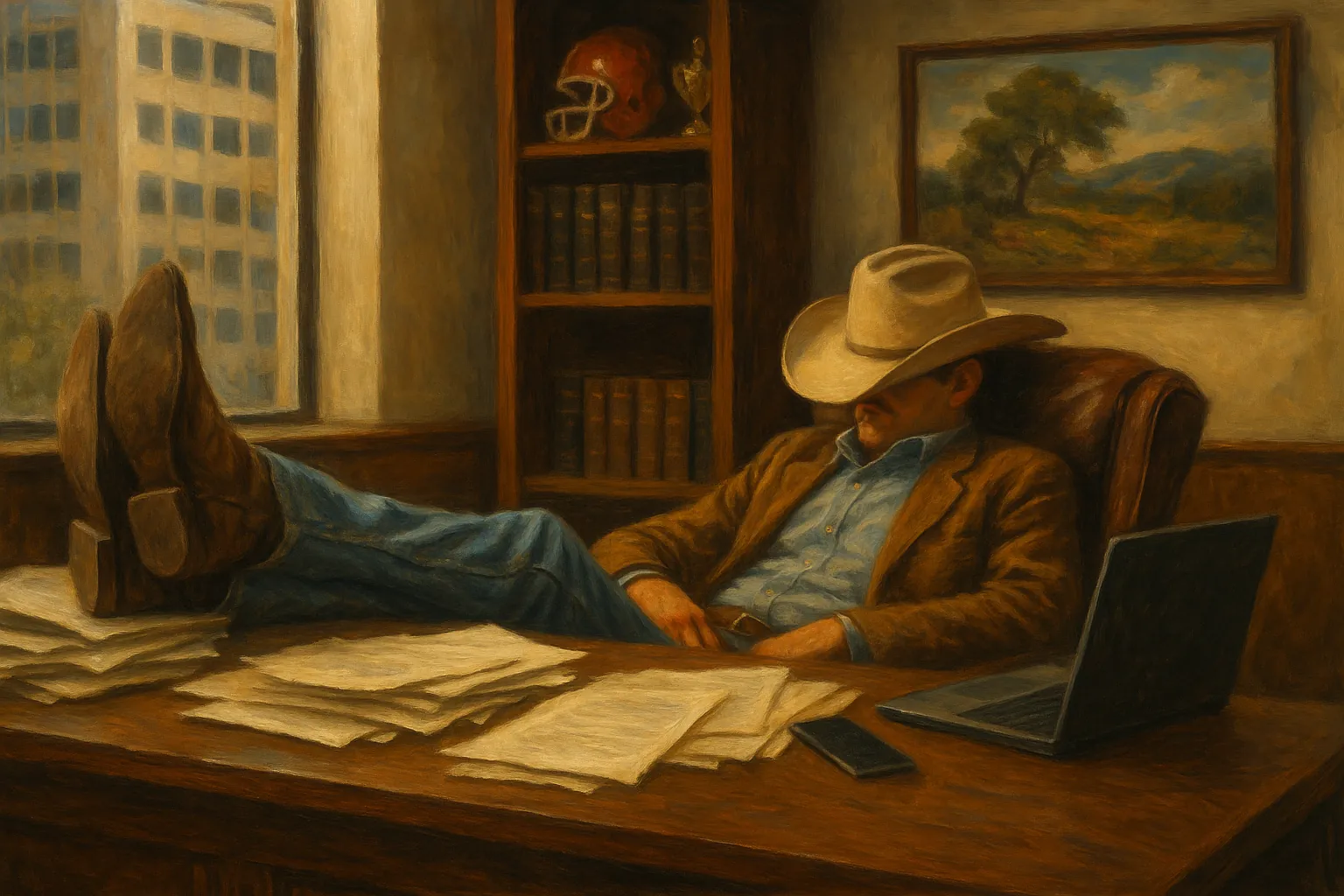Every two years, the Texas Legislature convenes for just 140 days. That’s it. In a state with more than 30 million residents, a $170 billion annual budget, and a sprawling array of policy challenges, this limited schedule has raised eyebrows.
Critics call it outdated, inefficient, even lazy. But is that fair?
Texas is one of just four states with a biennial legislative session (convening for one session every two years), alongside Montana, Nevada, and North Dakota. Under Article III, § 5 of the Texas Constitution, the Legislature meets in regular session beginning in January of each odd-numbered year (e.g. 2023, 2025, 2027), with a hard cap of 140 calendar days.
Any work outside that window requires a special session, which can only be called by the governor and is limited to topics the governor chooses.
Even within the 140-day window, Texas lawmakers operate under a compressed internal calendar set partly by the state constitution and partly by chamber rules. The Constitution bars passage of most bills during the first 60 days unless designated as emergency items by the governor. After that, a series of fixed deadlines—covering bill filing, committee action, and floor votes—further narrows the window. Much of the legislative work is crowded into a few hectic weeks, especially in April and early May, leaving little time for deliberation or revision.
Compared to the year-round legislatures in many other states, Texas’s model can seem like an anachronism. But it’s also a product of deliberate design—one rooted in the state’s early history and ongoing political philosophy. This article explores how the system came to be, how it functions today, and what its supporters and critics say about it.
How Texas Compares to Other Large States
Texas is unique among large-population states for retaining a biennial schedule.
| State | Session Frequency | Session Length |
|---|---|---|
| Texas | Biennial | 140 days |
| California | Annual | Nearly year-round |
| Florida | Annual | 60 days |
| New York | Annual | ~6 months |
| Illinois | Annual | ~5–6 months |
| Pennsylvania | Annual | ~10 months |
Comparison to Other Biennial States
Texas’s legislative schedule is comparable to that of a handful of small Western states.
- Montana: 90-day biennial session; rare special sessions; minimal interim activity.
- Nevada: 120-day biennial session; occasional special sessions; strong fiscal and policy committees active between sessions.
- North Dakota: 80-day biennial session; rare special sessions; active interim committee system that substitutes for full legislative activity.
All three states are significantly smaller than Texas in both population and budget size, making Texas a national outlier in applying the biennial model to a large and complex state.
Historical Origins of the Biennial Schedule
The Texas Legislature’s part-time structure is a legacy of 19th-century conditions, both practical and political. Under the 1836 Constitution of the Republic of Texas, the national Congress was required to meet annually, but the demands of frontier governance soon made a lighter schedule more practical. After statehood, the 1845 Constitution and its successors adopted biennial legislative sessions—a pattern that continued for over two decades.
Travel across the vast, sparsely populated state was difficult and time-consuming. Lawmakers journeying from the Panhandle or the Rio Grande Valley could spend weeks reaching Austin by horse, wagon, or rail. Holding sessions only every other year made sense for a society with limited infrastructure and a slower legislative rhythm.
That tradition was interrupted under the 1869 Constitution, drafted during military occupation in the aftermath of the Civil War. The Reconstruction-era government centralized power in Austin, gave broad authority to the governor and the legislature, and shifted the Legislature to annual sessions. The Republican-controlled government was closely tied to federal mandates and viewed by many Texans at the time as intrusive and unrepresentative.
When that era ended, Texas Democrats—newly returned to power—sought to dramatically roll back the reach of state government. The result was the Constitution of 1876, which remains in effect today. That document intentionally restricted legislative power by mandating biennial sessions, imposing strict limits on spending and debt, and dispersing authority across multiple elected offices and agencies.
Advertisement
Why So Few Days?
The biennial schedule has remained in place, largely unchanged, for nearly 150 years. While other states moved toward annual meetings, Texas preserved the original design.
Despite the limited calendar, Texas lawmakers face an intense workload when they are in session. In 2023, more than 8,000 bills and resolutions were filed. Committee hearings, floor debates, and behind-the-scenes negotiations are crammed into long days and late nights. The pace is chaotic, and the rules are strict: after a certain point in the regular session, no new bills can be filed, and procedural deadlines arrive in waves.
What Lawmakers Do After Session
When the regular session ends in May, the Texas Legislature enters what’s known as the interim period—a stretch of roughly 18 months in which lawmakers are not in formal session but remain involved in the political and policy life of the state. While the Capitol chambers fall silent, legislative work continues in less visible but still meaningful ways.
Much of the early interim is spent in the districts. Lawmakers return home to their jobs and families. They meet with constituents, attend local events, and address community issues.
Although legislation is no longer moving, the groundwork for future bills begins here. Legislators often consult with advocates, interest groups, and agency officials about ideas for upcoming proposals. At the same time, select lawmakers participate in interim committee assignments issued by the Speaker or Lieutenant Governor, which direct the study of complex topics—such as school finance, energy policy, or border security—that will likely reemerge in the next session.
If the governor calls a special session, the rhythm changes quickly. Special sessions may last up to 30 days and are limited to subjects chosen by the governor. In recent years, these have become increasingly frequent. In 2021, Governor Abbott convened three back-to-back specials. In 2023, the total reached four, largely due to impasses over school funding and property taxes. While regular sessions are broad and open-ended, special sessions are narrowly focused.
Meanwhile, the political calendar continues. Lawmakers facing re-election are often deep in preparation for the March primaries in even-numbered years. Fundraising, advertising, and voter outreach consume time and attention, even as policy planning unfolds in parallel. Those who survive the primaries then face the general election in November.
As the next session approaches, the final two months of the interim—November and December of even-numbered years—mark a return to Capitol-focused preparation. Returning lawmakers begin to finalize legislation, arrange staff, and coordinate policy priorities. Newly elected members attend orientation sessions led by the House and Senate leadership, the Texas Legislative Council, and other legislative support agencies. This onboarding introduces new lawmakers to the rules, facilities, ethics regulations, and bill filing systems they’ll rely on come January.
One of the most critical tasks in this pre-session period is staffing. Legislative offices operate with small teams—typically including a chief of staff, legislative director, district director, and executive assistant, though the structure varies. These positions are funded through each member’s state office budget, but hiring decisions and salaries are left to the discretion of the legislator. Some offices also bring on interns or policy aides to handle specific subject areas. In the House, preparations for session also include meetings and negotiations related to the upcoming Speaker of the House election, which is the first order of business on opening day.
Though the Texas Legislature only meets formally every two years, the reality is that lawmakers are busy throughout much of the cycle, even when the legislature is out of session. Between constituent casework, committee obligations, policy development, political campaigning, and special sessions, the job extends well beyond the 140 days at the Capitol.
Still, the Texas system is built on the expectation that legislators will not treat the role as a full-time career. Most hold other jobs—whether as attorneys, ranchers, or real estate agents—balancing public service with private employment.
Outside Employment and the Citizen-Legislator Model
The Texas Legislature is structured as a part-time body, and the compensation reflects that design. Legislators receive a salary of $7,200 per year, plus a daily per diem during session, which is intended to cover expenses but not to serve as a full-time wage. As a result, most legislators maintain outside employment.
Some members practice law or run small businesses, while others work in agriculture, education, finance, or consulting. A few are retired.
Supporters of this model argue that it ensures lawmakers remain connected to the everyday concerns of working Texans and prevents the rise of a professional political class.
Critics, however, contend that it disadvantages those with inflexible or lower-paying jobs and may restrict legislative service to the independently wealthy, self-employed, or those with generous employers. Others raise concerns about potential conflicts of interest, especially when legislators vote on matters related to their personal industries. In some cases, interest groups may try to sway lawmakers by offering them consulting contracts, job opportunities, or other financial incentives during the long interim period.
Advertisement
The Case For a Part-Time Legislature
Supporters of Texas’s part-time legislative model argue that it embodies a fundamental principle of limited government: the idea that elected office should be a temporary trust, not a permanent career. By restricting the legislative calendar to just 140 days every two years, the system forces lawmakers to prioritize, focus, and avoid excessive lawmaking. In theory, this helps prevent overregulation, bloated government programs, and reactive policymaking driven by the news cycle or lobbyist pressure.
Texas’s part-time structure also reflects a deeper skepticism of centralized power, a thread that runs through the state’s political culture from its founding as an independent republic to the present day. By limiting the amount of time legislators spend in Austin, the system deliberately diffuses power across the state—placing more responsibility on local governments, executive agencies, and citizens themselves. It discourages the kind of professionalized, full-time political class that has emerged in some other large states, where legislators may draw six-figure salaries and work year-round within entrenched party structures.
For many Texans, this is not a flaw—it is a feature. The idea that government should be “close to the people” is baked into the state’s constitutional framework. A part-time legislature reinforces the expectation that lawmakers should live, work, and remain rooted in their communities. Rather than spending years cloistered in the Capitol, they are expected to return home and live under the very laws they helped pass. This connection to everyday life can, in principle, produce more grounded, representative policymaking.
Proponents also argue that the relative infrequency of session encourages long-term thinking, rather than the short-term political maneuvering that can dominate annual legislatures.
With less pressure to react to each controversy or election cycle, lawmakers may be more likely to consider the structural or generational consequences of major policy changes. The biennial rhythm can promote patience, planning, and restraint—qualities not always associated with full-time legislative bodies.
The Case Against a Part-Time Legislature
Critics of the part-time legislative model argue that it is ill-suited to the size, complexity, and fast-changing nature of modern Texas. While the 140-day biennial schedule is meant to impose discipline and restraint, it also forces lawmakers to confront major issues under severe time constraints. Entire state budgets, tax code revisions, public education reforms, and emergency measures must be debated and passed within a few months. As a result, critical priorities are often handled in a rushed manner—or simply not addressed at all.
The compressed timeline leaves little room for thoughtful deliberation, especially on complex or technical matters. Many lawmakers, particularly those with little policy background or staff support, simply do not have the time to study the details of every proposal that comes before them. This lack of subject-matter depth can lead to floor debates and votes on legislation that even experienced legislators may not fully understand.
Rather than empowering ordinary citizens, critics argue that this arrangement actually shifts power into the hands of a professionalized lobbyist class. With limited time and limited resources, lawmakers frequently rely on outside organizations, advocacy groups, and industry associations to help draft bills and provide briefings. In practice, this means that many bills are written, shaped, or shepherded by entities with deep institutional knowledge and vested interests—rather than by the elected officials themselves.
Another common criticism is the issue of legislative pay. At just $7,200 per year plus per diem during session, compensation is far below what most professionals could accept without personal financial sacrifice. While this is meant to prevent careerism, it also discourages qualified candidates—especially working-class Texans, younger professionals, or those with families—from seeking office. Those who do serve often have independent wealth, flexible self-employment, or institutional support. In this way, the part-time structure may unintentionally privilege the wealthy and disconnected, rather than ensuring that the Legislature is truly representative of the population.
Critics also point to the Legislature’s limited ability to conduct meaningful oversight of executive agencies and long-term policy implementation. While there are interim committee hearings and the Legislative Budget Board continues to monitor state spending between sessions, oversight tends to be spotty and reactive, not consistent or systematic. In contrast to Congress, which has standing committees operating year-round, the Texas Legislature often lacks the bandwidth to hold agencies accountable outside the narrow window of a regular session. One notable exception is the Sunset Advisory Commission, which performs detailed periodic reviews of state agencies—but even that process reaches only a handful of entities per cycle.
Finally, the part-time model creates a structural deficit in institutional knowledge and policy continuity. The long breaks between sessions and relatively high turnover mean that expertise is often concentrated not in elected officials, but in career staff, lobbyists, and agency personnel. Lawmakers who do return may find it difficult to maintain momentum on complex policy goals, while newly elected members must scramble to get up to speed with little time for training or research. This can make the legislative process more vulnerable to rushed judgments, shallow debate, or outside manipulation.
In short, while the Texas model is designed to promote limited government and citizen leadership, critics contend that it can result in rushed decisions, unrepresentative leadership, diminished oversight, and policymaking dominated by those with the time, money, and access to shape outcomes behind the scenes.
A System Shaped by History, Challenged by Complexity
Texas’s part-time Legislature is one of the most distinctive features of its state government—a legacy of 19th-century values and frontier pragmatism. It reflects a constitutional design grounded in limited government, local autonomy, and a deep wariness of centralized political power.
That structure continues to shape how Texas governs today. Supporters view it as a safeguard against overreach and a way to keep lawmakers close to the people. Critics see a model that struggles to meet the demands of a fast-growing, complex state—one that often defers to executive agencies and outside interests by default.
Whether the biennial system still serves the long-term needs of modern Texas remains a subject of ongoing debate. But it is clear that the system is not accidental. It is the product of history, ideology, and a deliberate choice to do things differently.



